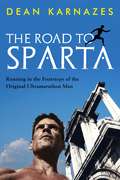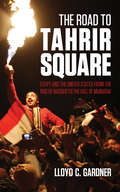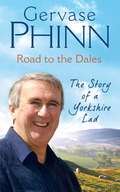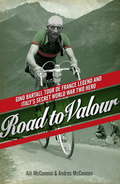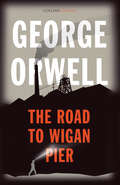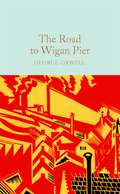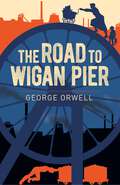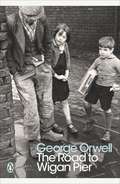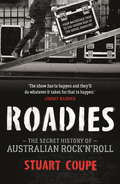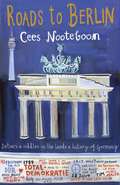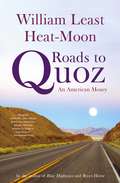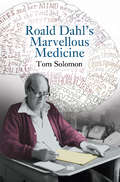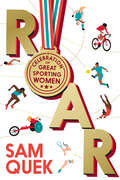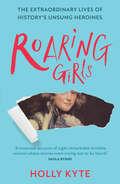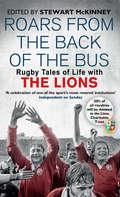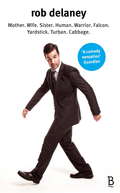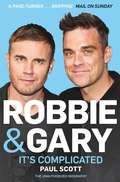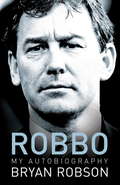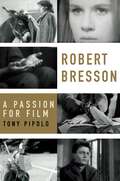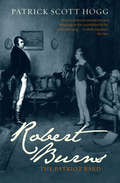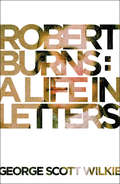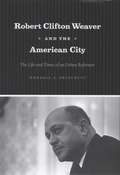- Table View
- List View
The Road to Sparta: Running in the Footsteps of the Original Ultramarathon Man
by Dean KarnazesIn 490 BCE Pheidippides ran for 36 hours straight from Athens to Sparta to seek help in defending Athens from a Persian invasion. He was hailed as a hero and his run stands enduringly as one of greatest physical accomplishments in history.Dean Karnazes honours this achievement and his own Greek heritage by attempting this ancient journey in modern times. His account of running the gruelling Spartathlon, fuelled only by the figs, olives and meats available to Pheidippides, will captivate even the most sedentary readers.
The Road to Tahrir Square: Egypt and the United States from the Rise of Nasser to the Fall of Mubarak
by Lloyd C. GardnerWhen protesters in Egypt began to fill Cairo's Tahrir Square on January 25, 2011—and refused to leave until their demand that Hosni Mubarak step down was met—the politi of the region changed overnight. And the United States' long friendship with the man who had ruled under emergency law for thirty years came starkly into question. The Road to Tahrir Square is the first book to connect past and present—from Franklin D. Roosevelt's brief meeting with King Farouk near the end of World War II, to Barack Obama's 2009 speech in Cairo, and the recent fall of Mubarak—offering readers an understanding of the events and forces determining American policy in this important region. Making full use of the available records, including the controversial WikiLeaks archive, renowned historian Lloyd C. Gardner shows how the United States has sought to influence Egypt through economic aid, massive military assistance, and CIA manipulations—an effort that has immediate implications for how the current crisis will alter the balance of power in the Middle East. As millions around the world ponder how the Egyptian Revolution will change the face of the region and the world, here is both a fascinating story of past policies and an essential guide to possible futures. 'When it comes to understanding the tangle of contradictions addling present-day US policy in the Arab world, Lloyd Gardner has become our most astute guide. This compact, timely, and altogether admirable study is his best yet.' Andrew J. Bacevich, author of Washington Rules: America's Path to Permanent War 'This book is a clear, concise, and insightful account of Egypt's long decline, focusing on both the mistakes of its own leaders and the ignorant meddling of outside powers.' Stephen Kinzer, former New York Times correspondent and author of Overthrow: America's Century of Regime Change from Hawaii to Iraq
Road to the Dales: The Story of a Yorkshire Lad
by Gervase PhinnA unique look into the childhood experiences of Gervase Phinn in Road to the Dales.Gervase tells of a life full of happiness, conversation, music and books shared with his three siblings, mother and father. This book is a snapshot of growing up in Yorkshire in the 1950s - reminisce with Gervase, and share in his personal journey - of school days and holidays as well as his tentative steps into the adult world. Devour numerous uproarious stories including the incident involving a broken greenhouse, crashing his brother's newly restored bike as well as secrets about his first dates, adventures at summer camp, family trips to Blackpool and many other captivating tales.With a wicked ear for the comical, and a sharp eye for detail, Road to the Dales visits poignant moments, significant events and precious memories from a boy called Gervase Phinn.Gervase Phinn is an author and educator from Rotherham who, after teaching for fourteen years in a variety of schools, moved to North Yorkshire to be a school inspector. He has written autobiographies, novels, plays, collections of poetry and stories, as well as a number of books about education. He holds five fellowships, honorary doctorates from Hull, Leicester and Sheffield Hallam universities, and is a patron of a number of children's charities and organizations. He is married with four adult children. His books include The Other Side of the Dale, Over Hill and Dale, Head Over Heels in the Dales,The Heart of the Dales, Up and Down in the Dales and Trouble at the Little Village School.
Road to Valour: Gino Bartali – Tour de France Legend and World War Two Hero
by Aili McConnon Andres McConnonAn Italian SCHINDLER'S LIST, this is the inspirational story of Gino Bartali, who made the greatest comeback in Tour de France history and secretly aided the Italian Resistance during the Second World War.ROAD TO VALOUR is the inspiring, against-the-odds story of Gino Bartali, the cyclist who made the greatest comeback in Tour de France history and still holds the record for the longest gap between victories. Yet it was his actions during the Second World War, when he secretly aided the Resistance, rather than his remarkable exploits on a bike, that truly cemented his place in the hearts and minds of the Italian people.Based on nearly ten years of research, and including fascinating new interviews, this is the only book written that fully explores the scope of Bartali's wartime work. A breathtaking account of one man's unsung heroism and his resilience in the face of adversity, this is an epic tale of courage, comeback and redemption, and the untold story of one of the greatest athletes of the twentieth century.
The Road to Wigan Pier: Large Print (Collins Classics)
by George OrwellHarperCollins is proud to present its incredible range of best-loved, essential classics.
The Road to Wigan Pier: Large Print (Macmillan Collector's Library #280)
by George OrwellThe Road to Wigan Pier is a book in two parts: the first half is Orwell’s description of working-class life in industrial communities of the north of England, the second examines his own political views.Part of the Macmillan Collector’s Library; a series of stunning, clothbound, pocket-sized classics with gold foiled edges and ribbon markers. These beautiful books make perfect gifts or a treat for any book lover. This edition is introduced by journalist and author Amelia Gentleman.The Road to Wigan Pier is an insightful and powerful account of lives lived in poverty and deprivation in a time of low wages and meagre government support. Orwell describes dismal housing (including the lodging house where he stays), harsh working conditions and the devastating effects of unemployment. And he also vividly describes the courage and dignity of the people he meets. In the second half of the book, Orwell examines his own political and social affiliations with an impressive ability to provoke and to question. He defends middle-class values whilst critiquing the failures of his own class, he advocates socialism whilst criticizing the socialist movement in England.
The Road to Wigan Pier (Arcturus Essential Orwell)
by George Orwell'We are living in a world in which nobody is free, in which hardly anybody is secure, in which it is almost impossible to be honest and to remain alive.'In 1936, at the behest of his publisher, George Orwell set out for Wigan to observe what life was really like in some of the most deprived areas of Britain's industrial heartlands. The result was a revealing and unflinching portrait of the working class of northern England.Brilliantly written, strongly opinionated, and uniquely affecting, The Road to Wigan Pier provides insights into the poverty caused by the Great Depression, from the horrendous working conditions in the mines to the daily struggle of working people to provide enough food for the family. It is followed by a personal and often humorous consideration of the state of socialism in the country.Part polemic, part social reportage, Orwell's classic work is a harrowing and intimate account of inequality filled with observations that remain relevant today.ABOUT THE SERIES: Arcturus Essential Orwell presents George Orwell's most acclaimed fiction and non-fiction titles with striking contemporary cover-designs. These unique paperback editions are wonderful collectibles which celebrate one of the most important voices of the 20th century.
The Road to Wigan Pier (Penguin Modern Classics)
by George Orwell Richard HoggartA searing account of George Orwell's observations of working-class life in the bleak industrial heartlands of Yorkshire and Lancashire in the 1930s, The Road to Wigan Pier is a brilliant and bitter polemic that has lost none of its political impact over time. His graphically unforgettable descriptions of social injustice, cramped slum housing, dangerous mining conditions, squalor, hunger and growing unemployment are written with unblinking honesty, fury and great humanity. It crystallized the ideas that would be found in Orwell's later works and novels, and remains a powerful portrait of poverty, injustice and class divisions in Britain.Includes illustrations, explanatory footnotes, and an introduction by Richard Hoggart.
Roadies: The Secret History of Australian Rock'n'Roll
by Stuart CoupeThis is your backstage pass to the hidden side of the music industry - the tantrums, the fights, the tensions, the indulgence, the sex, the alcohol, the drugs. The roadies see it all, and now they are sharing their secrets. Roadies are the unsung heroes of the Australian music industry. They unload the PAs and equipment, they set it all up, they make sure everything is running smoothly before, during and after the gigs. Then they pack everything up in the middle of the night, put it in the back of the truck and hit the road to another town - to do it all over again. They know everything about the pre- and post-show excesses. They bear witness to overdoses, the groupies, the obsessive fans. They are part of - and often organise - all the craziness that goes on behind the scenes of the concerts and pub gigs you go to. From The Rolling Stones to AC/DC, Bob Marley to Courtney Love, Sherbet to The Ted Mulry Gang, INXS to Blondie - these guys have seen it all. And now they're stepping onto the stage and talking.The Roadies' Creed: If it's wet, drink it. If it's dry, smoke it. If it moves, **** it. If it doesn't move, throw it in the back of the truck.'Fabulous . . . a bold portrait' SYDNEY MORNING HERALD on Stuart Coupe's GUDINSKI
Roads to Berlin
by Cees NooteboomRoads to Berlin maps the changing landscape of Germany, from the period before the fall of the Wall to the present. Written and updated over the course of several decades, an eyewitness account of the pivotal events of 1989 gives way to a perceptive appreciation of its difficult passage to reunification. Nooteboom's writings on politics, people, architecture and culture are as digressive as they are eloquent; his innate curiosity takes him through the landscapes of Heine and Goethe, steeped in Romanticism and mythology, and to Germany's baroque cities. With an outsider's objectivity he has crafted an intimate portrait of the country to its present day.
Roads to Quoz: An American Mosey
by William Least Heat-MoonAbout a quarter century ago, a previously unknown writer named William Least Heat-Moon wrote a book called Blue Highways. Acclaimed as a classic, it was a travel book like no other. Quirky, discursive, endlessly curious, Heat-Moon had embarked on an American journey off the beaten path. Sticking to the small places via the small roads -- those colored blue on maps -- he uncovered a nation deep in character, story, and charm. Now, for the first time since Blue Highways, Heat-Moon is back on the backroads. Roads to Quoz is his lyrical, funny, and touching account of a series of American journeys into small-town America.
Roald Dahl's Marvellous Medicine
by Tom SolomonMost people know Roald Dahl as a famous write of children’s books and adult short stories, but few are aware of his fascination with medicine. Right from his earliest days to the end of his life, Dahl was intrigued by what doctors do, and why they do it. During his lifetime, he and his family suffered some terrible medical tragedies: Dahl nearly died when his fighter plane went down in World War II; his son had severe brain injury in an accident; and his daughter died of measles infection of the brain. But he also had some medical triumphs: he dragged himself back to health after the plane crash, despite a skull fracture, back injuries, and blindness; he was responsible for inventing a medical device (the Wade-Dahl-Till valve) to treat his son's hydrocephalus (water on the brain), and he taught his first wife Patricia to talk again after a devastating stroke. His medical interactions clearly influenced some of his writing – for example the explosive potions in George’s Marvellous Medicine. And sometimes his writing impacted on events in his life – for example the research on neuroanatomy he did for his short story William and Mary later helped him design the valve for treating hydrocephalus. In this unique book, Professor Tom Solomon, who looked after Dahl towards the end of his life, examines Dahl’s fascination with medicine. Taking examples from Dahl’s life, and illustrated with excerpts from his writing, the book uses Dahl’s medical interactions as a starting point to explore some extraordinary areas of medical science. Solomon is an award-winning science communicator, and he effortlessly explains the medical concepts underpinning the stories, in language that everyone can understand. The book is also peppered with anecdotes from Dahl’s late night hospital discussions with Solomon, which give new insights into this remarkable man’s thinking as his life came to an end.
Roald Dahl's Marvellous Medicine
by Tom SolomonMost people know Roald Dahl as a famous write of children’s books and adult short stories, but few are aware of his fascination with medicine. Right from his earliest days to the end of his life, Dahl was intrigued by what doctors do, and why they do it. During his lifetime, he and his family suffered some terrible medical tragedies: Dahl nearly died when his fighter plane went down in World War II; his son had severe brain injury in an accident; and his daughter died of measles infection of the brain. But he also had some medical triumphs: he dragged himself back to health after the plane crash, despite a skull fracture, back injuries, and blindness; he was responsible for inventing a medical device (the Wade-Dahl-Till valve) to treat his son's hydrocephalus (water on the brain), and he taught his first wife Patricia to talk again after a devastating stroke. His medical interactions clearly influenced some of his writing – for example the explosive potions in George’s Marvellous Medicine. And sometimes his writing impacted on events in his life – for example the research on neuroanatomy he did for his short story William and Mary later helped him design the valve for treating hydrocephalus. In this unique book, Professor Tom Solomon, who looked after Dahl towards the end of his life, examines Dahl’s fascination with medicine. Taking examples from Dahl’s life, and illustrated with excerpts from his writing, the book uses Dahl’s medical interactions as a starting point to explore some extraordinary areas of medical science. Solomon is an award-winning science communicator, and he effortlessly explains the medical concepts underpinning the stories, in language that everyone can understand. The book is also peppered with anecdotes from Dahl’s late night hospital discussions with Solomon, which give new insights into this remarkable man’s thinking as his life came to an end.
Roar: A Celebration of Great Sporting Women
by Sam QuekFrom the tennis court to the boxing ring, the athletics track to the football pitch, the visibility of women in sport has been gathering pace. Women's competitions are increasingly popular. In Roar Sam takes a deep dive into the experiences of some of sport's most high-profile female athletes - some have overcome heartbreaking adversity to reach the top of their game; others have succeeded in the face of prejudice. Like Sam, all have been propelled by sheer grit and determination to succeed. Many now campaign for women's equality and acceptance in sport, knowing the confidence it can bring young girls and the message that they can achieve anything. Featuring a series of candid interviews from some of sport's most successful women, Sam lifts the lid on what it takes to reach those heights: from coping with puberty to foregoing teenage fun to pursue a dream; from the punishing physical training schedule to the mental power needed to win or bounce back from defeat; from the pressure of the media spotlight to the challenge of competing as a new mother. And, what it feels like in that magical moment when you step up to the podium knowing every sacrifice has been worth it.Roar is a celebration of the bold and fearless - the women empowering future generations to follow in their footsteps - but it is also an inspiring look at how sport can change lives and challenge society.
Roaring Girls: The Forgotten Feminists Of British History
by Holly Kyte‘Extraordinary’ Woman&Home A Roaring Girl was loud when she should be quiet, disruptive when she should be submissive, sexual when she should be pure, ‘masculine’ when she should be ‘feminine’. Meet the unsung heroines of British history who refused to play by the rules.
Roars from the Back of the Bus: Rugby Tales of Life with the Lions
by Stewart McKinneyRoars from the Back of the Bus is an absorbing, amusing and at times moving collection of tales that give a rare insight into the camaraderie that exists between players at the top of their game, showing that relationships forged through experiences on a Lions tour last a lifetime. From the first Tour in 1888, it showcases characters with immense personality who fought together in wars or on rugby pitches in foreign lands, and who shared a bond developed through touring as representatives of the home nations. Despite the changes to the game after the advent of professionalism, the experiences of Jamie Heaslip, Brian O’Driscoll and Joe Worsley are still similar in some ways to those of earlier intrepid tourists like Blair Mayne, Lewis Jones, Sir Carl Aarvold or David Rollo. Containing defining memories and private insights from across the tours and the decades, Roars from the Back of the Bus shows that the Lions ethos remains strong at the heart of every team.
Rob Delaney: Mother. Wife. Sister. Human. Warrior. Falcon. Yardstick. Turban. Cabbage.
by Rob DelaneyRob Delaney is a father, a husband, a comedian, a writer. He is the author of an endless stream of beautiful, insane jokes on Twitter. He is sober. He is sometimes brave. He speaks French. He has bungee-jumped off the Manhattan Bridge. He enjoys antagonizing political figures, powerful retailers and the Kardashians. He listens to metal while he works out. He broke into an abandoned mental hospital with his mother. He played Sir Lancelot in Camelot. He has battled depression. He is funny as s***. He cleans up well. He and Margaret Atwood have a thing going on Twitter. He is lucky to be alive.
Robbie and Gary: It's Complicated - The Unauthorised Biography
by Paul ScottRobbie Williams and Gary Barlow - together and apart, these two men have dominated the charts for the best part of twenty years. And it is their fractured 'bromance' that has shaped the history of one of the world's most successful bands.Based on years of in-depth research, this authoritative biography uncovers the truth about their tortured relationship. It reveals why sixteen-year-old Robbie idolised the older and more talented Gary when, as unknowns, they were put together in the newly formed Take That. We see how the stresses brought on by fame and money destroyed their fragile friendship and resulted in Robbie trying to take Gary's position as front man. We also discover how far they'd go to hurt each other during a feud that lasted fifteen years and continued to shape their solo careers.Explaining why the two men finally reconciled in 2010, and analysing how their reunion is coping with the stresses of touring once more, Robbie and Gary offers a unique insight into the lives of these much loved stars.
Robbo - My Autobiography: An extraordinary career
by Bryan RobsonBryan Robson is widely remembered as a fearless and inspirational player and captain, both for club and country, whose presence lifted team-mates and intimidated opponents. At his peak, he was acknowledged as the most complete midfield player in the country, and played at the highest level despite a series of devastating injuries. He began his playing career at West Bromwich Albion, then moved to Manchester United in 1981 for a then record British transfer fee of £1.5 million. He soon became captain, and enjoyed regular Cup success, eventually winning the Championship. He also won 90 caps for England, 65 of them as captain. His autobiography reveals a fascinating insight into his days with the England and United camps and characters such as Paul Gascoigne, Gary Lineker, Roy Keane and Alex Ferguson. He puts the record straight on the 'drink culture' that Ferguson sought to stamp out at United, and describes his pain when he discovered he was surplus to the manager's requirements. He candidly reflects on the highs and lows of his football life, and discusses incidents on the pitch as well as some of the clashes that have happened behind the scenes.
Robert Bresson: A Passion for Film
by Tony PipoloPerhaps the most highly regarded French filmmaker after Jean Renoir, Robert Bresson created a new kind of cinema through meticulous refinement of the form's grammatical and expressive possibilities. In thirteen features over a forty-year career, he held to an uncompromising moral vision and aesthetic rigor that remain unmatched. Robert Bresson: A Passion for Film is the first comprehensive study to give equal attention to the films, their literary sources, and psycho-biographical aspects of the work. Concentrating on the films' cinematographic, imagistic, narrative, and thematic structures, Pipolo provides a nuanced analysis of each film-including nearly 100 illustrations-elucidating Bresson's unique style as it evolved from the impassioned Les Anges du péche to such disconsolate meditations on the world as The Devil Probably and L'Argent. Special attention is also given to psychosexual aspects of the films that are usually neglected. Bresson has long needed a thoroughgoing treatment by a critic worthy to the task: he gets it here. From it emerges a provocative portrait of an extraordinary artist whose moral engagement and devotion to the craft of filmmaking are without equal.
Robert Bresson: A Passion for Film
by Tony PipoloPerhaps the most highly regarded French filmmaker after Jean Renoir, Robert Bresson created a new kind of cinema through meticulous refinement of the form's grammatical and expressive possibilities. In thirteen features over a forty-year career, he held to an uncompromising moral vision and aesthetic rigor that remain unmatched. Robert Bresson: A Passion for Film is the first comprehensive study to give equal attention to the films, their literary sources, and psycho-biographical aspects of the work. Concentrating on the films' cinematographic, imagistic, narrative, and thematic structures, Pipolo provides a nuanced analysis of each film-including nearly 100 illustrations-elucidating Bresson's unique style as it evolved from the impassioned Les Anges du péche to such disconsolate meditations on the world as The Devil Probably and L'Argent. Special attention is also given to psychosexual aspects of the films that are usually neglected. Bresson has long needed a thoroughgoing treatment by a critic worthy to the task: he gets it here. From it emerges a provocative portrait of an extraordinary artist whose moral engagement and devotion to the craft of filmmaking are without equal.
Robert Burns: The Patriot Bard (Canongate Classics Ser. #24)
by Patrick Scott HoggFollowing the 250th anniversary of the birth of Robert Burns (1759-96), Patrick Scott Hogg presents the greatest of Scotland's poets within the true context of his times. Exploding the Burns myth, Robert Burns: The Patriot Bard replaces the ram-stam lad of popular cliché with the real, living Burns - a Scottish patriot of the heart, an idealist who wished for 'Freedom and Liberty' for his beloved country, but also a man who was pragmatically a British patriot and risked his life for democratic reform. Here Burns is painted in his native colours as a highly complex, hyper-intelligent writer in both prose and poetry, not the semi-confused, contradictory simpleton of previous biographies. The fascinating legend of Burns as a ladies' man is placed where it should be - as less important than the message of the bard.The real day-to-day Burns was irascible, stubborn-minded, independent, controversial and opinionated. He detested many of his social superiors within the feudal order and attacked them as hypocrites and oppressors of the common people. The voice of Burns, always in the language of the people, and his idealist vision of a better world endeared him as a poet of humanity 'the world o'er'. Drawing from Burns' existing canon of poetry and letters, plus some newly attributed works suppressed for over two centuries, this life story is a roller-coaster narrative that charts the success and untimely death of the greatest songwriter of all time, the real Robert Burns.
Robert Burns: A Life In Letters
by George Scott WilkieWhat is often forgotten about Robert Burns is that he was a prolific writer of letters and had the ability to correspond with people from every walk of life. Whereas his poems and songs were composed in the Scots dialect, his letters were written in perfect English prose. Many of his letters to his platonic lover, Clarinda, are to be found here along with many from Clarinda to Burns. The depth of feeling portrayed in this correspondence between two young people is compelling reading. His letters of advice to his young brother, William, are both serious and amusing. A letter of apology following a night of revelry at Friar's Carse is a masterpiece in its own right, as indeed are many more. Burns wrote like a man possessed. His quill could stab like a rapier or be used as a broadsword to cut down his enemies. It was a tool in his seduction of the fair sex and was also used to flatter his aristocratic friends. He revelled in his correspondence with Mrs Francis Anna Dunlop simply because she was a descendant of William Wallace. He describes in graphic detail the problems he encountered with the family of Jean Armour, revealing his intention to flee to the West Indies. This selection of letters offers a fascinating insight into his lifes, his many romances, his fame and fortune and then his slide back to poverty and early death.
Robert Clifton Weaver and the American City: The Life and Times of an Urban Reformer
by Wendell E. PritchettFrom his role as Franklin Roosevelt’s “negro advisor” to his appointment under Lyndon Johnson as the first secretary of Housing and Urban Development, Robert Clifton Weaver was one of the most influential domestic policy makers and civil rights advocates of the twentieth century. This volume, the first biography of the first African American to hold a cabinet position in the federal government, rescues from obscurity the story of a man whose legacy continues to affect American race relations and the cities in which they largely play out. Tracing Weaver’s career through the creation, expansion, and contraction of New Deal liberalism, Wendell E. Pritchett illuminates his instrumental role in the birth of almost every urban initiative of the period, from public housing and urban renewal to affirmative action and rent control. Beyond these policy achievements, Weaver also founded racial liberalism, a new approach to race relations that propelled him through a series of high-level positions in public and private agencies working to promote racial cooperation in American cities. But Pritchett shows that despite Weaver’s efforts to make race irrelevant, white and black Americans continued to call on him to mediate between the races—a position that grew increasingly untenable as Weaver remained caught between the white power structure to which he pledged his allegiance and the African Americans whose lives he devoted his career to improving.
Robert Clifton Weaver and the American City: The Life and Times of an Urban Reformer
by Wendell E. PritchettFrom his role as Franklin Roosevelt’s “negro advisor” to his appointment under Lyndon Johnson as the first secretary of Housing and Urban Development, Robert Clifton Weaver was one of the most influential domestic policy makers and civil rights advocates of the twentieth century. This volume, the first biography of the first African American to hold a cabinet position in the federal government, rescues from obscurity the story of a man whose legacy continues to affect American race relations and the cities in which they largely play out. Tracing Weaver’s career through the creation, expansion, and contraction of New Deal liberalism, Wendell E. Pritchett illuminates his instrumental role in the birth of almost every urban initiative of the period, from public housing and urban renewal to affirmative action and rent control. Beyond these policy achievements, Weaver also founded racial liberalism, a new approach to race relations that propelled him through a series of high-level positions in public and private agencies working to promote racial cooperation in American cities. But Pritchett shows that despite Weaver’s efforts to make race irrelevant, white and black Americans continued to call on him to mediate between the races—a position that grew increasingly untenable as Weaver remained caught between the white power structure to which he pledged his allegiance and the African Americans whose lives he devoted his career to improving.
